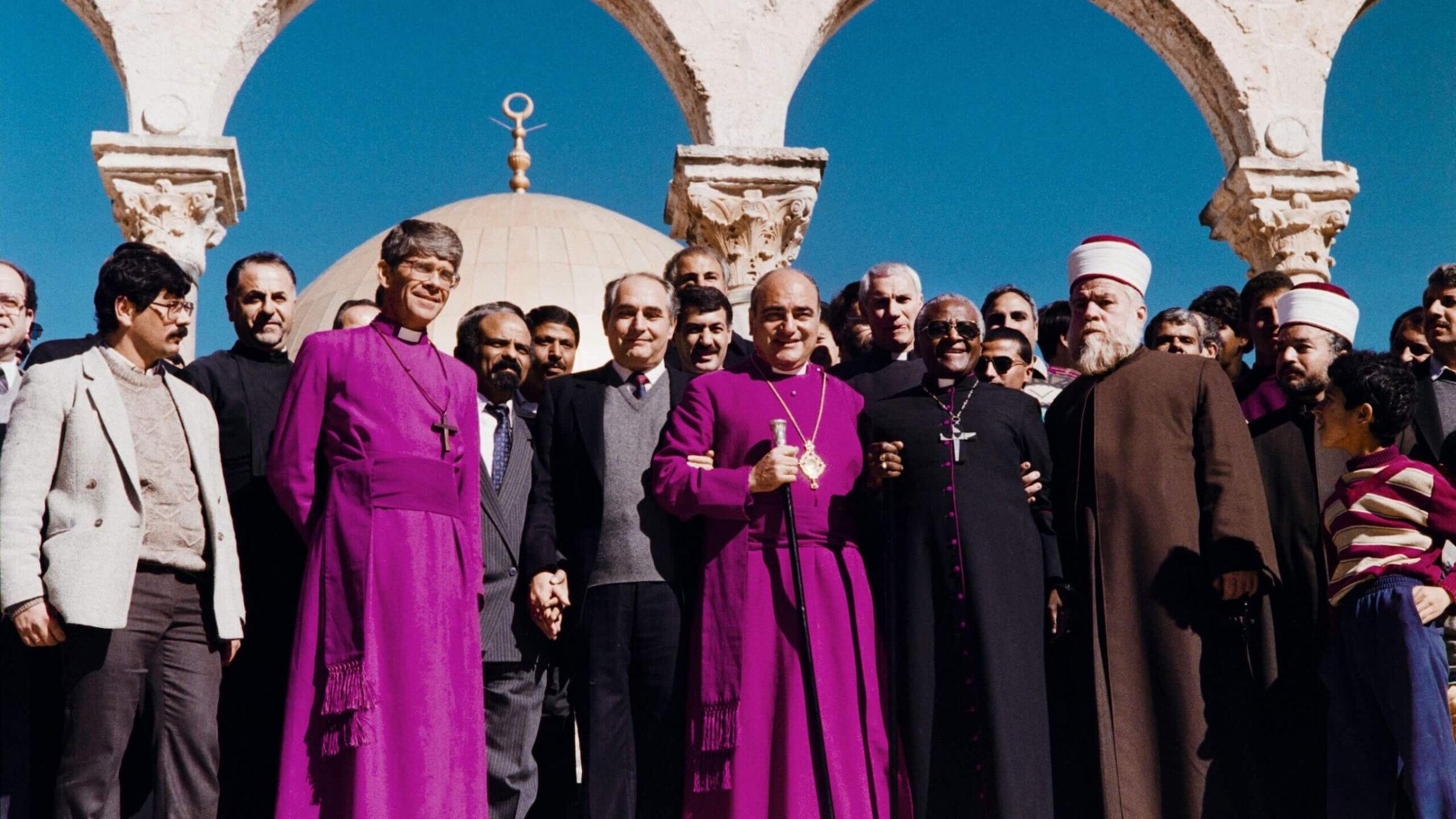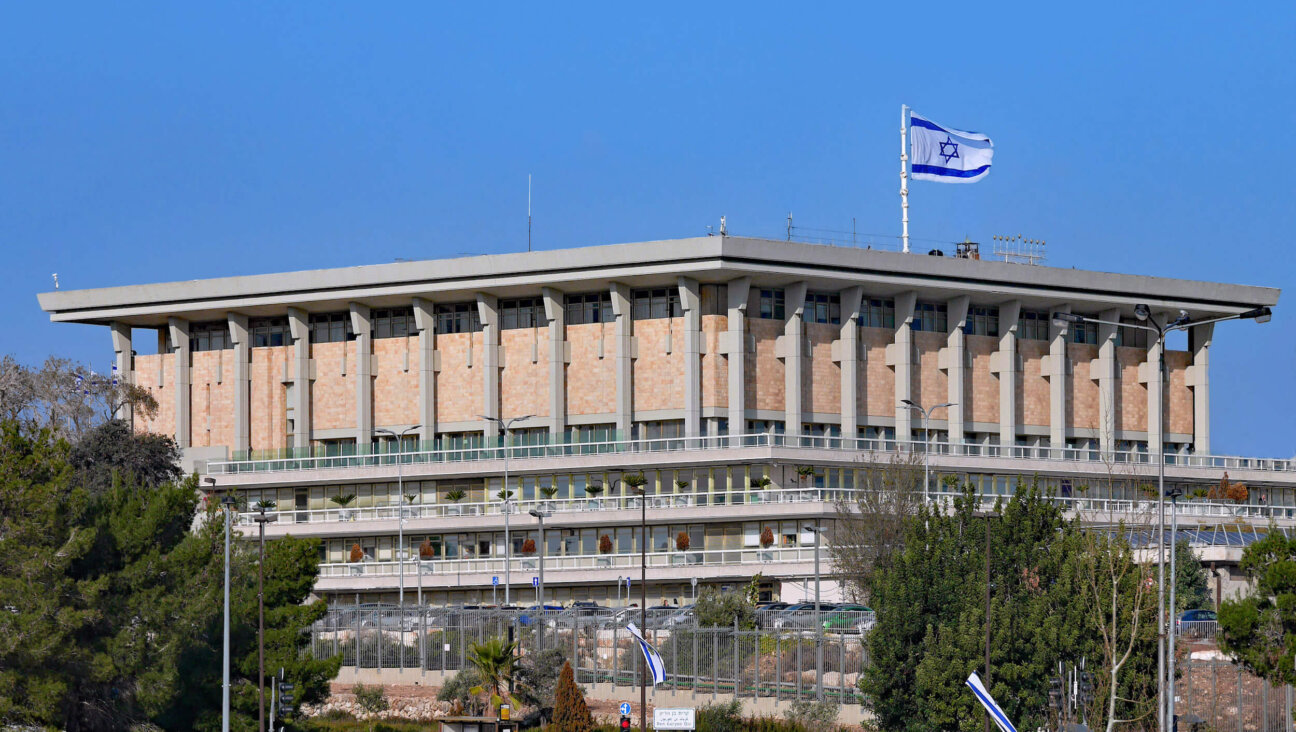As Desmond Tutu visited the Middle East in 1989, I thought peace was at hand — what went wrong?
Can Christmas still bring hope to the Holy Land, even in times of war and strife?

South African activist and Nobel laureate Desmond Tutu (third from right) poses with members of clergy and Palestinian leaders Faisal Husseini and Radwan Abu Ayash on December 23, 1989 during his visit in Jerusalem. Photo by FEINBLATT/AFP via Getty Images
JERUSALEM — It rained in Bethlehem this past Christmas Eve. But we hardly had the strength to look up in gratitude for the blessed downpour. Because, as in the time of Mary and Joseph, the Holy Land is contested space.
The Romans are gone, and Jews have replaced Judeans. The Muslims, who brought Allah’s word to an already scarred landscape in the seventh century, are now engaged with Jews in battle as bloody as any this poor land has ever seen.
As December yielded inexorably to January, and we in Jerusalem turned our calendars to 2024 with forlorn hope, I looked to history for a glimmer of insight. Recent history, my history: Christmas Eve 1989, when Bishop Desmond M. Tutu of South Africa came to bless Israelis and Palestinians — Jews, Christians and Muslims — in the very field where, 2,000 years before, stars had guided three shepherds to the stable where baby Jesus lay.
It was the time of the first intifada, when Palestinians rose up against Israel’s occupation of the West Bank and Gaza Strip with largely nonviolent protests, at least at first. Soon after the intifada started, in 1988, I became part of a small cohort of Israeli Jews — many of us immigrants from the United States and other English-speaking countries — who reached out to our Palestinian Christian and Muslim neighbors to try to combat the animosity roiling the streets and to enact an alternative of coexistence and mutual respect.
Our alliance emanated from Yedidya, a progressive, Orthodox minyan in Jerusalem. We were committed equally to our Jewish heritage and to our liberal western political heritage. Some in our group had been children in Europe during the Holocaust who wore their scars as pledges to fostering a postwar world of mutual respect and inclusiveness. Others were veterans of the civil rights movement in the U.S., seekers of justice who could not abide a society where violence raged and race or religion determined destiny.
We maintained a daily vigil against the occupation in front of the prime minister’s residence for the better part of a year. We also met in our homes in West Jerusalem and in Beit Sahour, a town next to Bethlehem, at the homes of our Palestinian counterparts.
Men and women of different ages and professions, we exchanged worldviews, recipes and advice for barren women over tea laced with regional spices. We invited our Muslim and Christian neighbors to our synagogue for dialogue, and hosted a basketball match in the courtyard outside the synagogue between our adolescent sons. One Friday afternoon, we Jews carried our cholent, a slow-cooking Sabbath stew, along with our babies and toddlers, across the fields to reach Beit Sahour before the sun set, to spend our day of rest as their guests.
It was a long trek. The main roads would have cut the journey to just over half an hour, but they were monitored by soldiers who would not have let us pass. Soldiers who could have been our own sons and daughters.
Our activities were based on our common humanity and mutual commitment to personal and political dignity, spiritual yearning and humility. They culminated in that 1989 Christmas Eve visit from Bishop Tutu, who had received the Nobel Peace Prize five years earlier for his work to dismantle apartheid in his homeland. He spoke in Shepherd’s Field, where the angels are said to have announced Christ’s birth; according to some Jewish traditions, it is also the site of Ruth’s nighttime encounter with Boaz in the Hebrew Bible.
Shepherd’s Field has been marked from the beginning, then, as a place associated with kindness, generosity and grace — as well as an early stage for interfaith dialogue. As we stood together under the clear, cold, star-studded sky, we believed so fervently that, indeed, peace was at hand between our peoples and among the three monotheistic religions in the Holy Land.
While we, Israelis and Palestinians, Christians, Jews and Muslims — doctors, teachers, musicians, pharmacists, writers, mothers, fathers — were trying to spin the quotidian threads of peace in Beit Sahour and Jerusalem, the politicians were working to weave its practical garments. It was the era of the Oslo peace process, which culminated in the historic White House handshake between Prime Minister Yitzhak Rabin and PLO leader Yaser Arafat in 1993–only to plummet to its nadir with Rabin’s assassination by an Israeli Jew two years later.
Sari Nusseibeh, former president of Al Quds University and a Palestinian activist with family ties to Jerusalem that go back many centuries, spoke about this last week at the Van Leer Institute in West Jerusalem. He said that Oslo, flawed as it was, created a true horizon for political settlement based on honest dialogue and tough negotiations. There were academic exchanges and economic initiatives as well as grass-roots groups like the one I’d been involved in.
But the forces of xenophobic hatred and religious fundamentalism also grew during that period. During the height of the violent second intifada, in 2002, a number of us — including some of the founding members of Yedidya — tried to help the residents of Jabel Mukaber, a Palestinian neighborhood in East Jerusalem, who were suffering dislocation and isolation from the insidious separation barrier that Israel had snaked through the West Bank. But when, in 2008 and again in 2014, residents of Jabel Mukaber killed people in West Jerusalem — preceded and followed by violent acts by Jewish Israelis — it became harder to maintain the faith and the energy to keep working for change.
Rabin’s murder had killed prospects for peace and justice for a whole generation of Israelis and Palestinians. It was inspired in part by the rhetoric of Benjamin Netanyahu, then the leader of the opposition and now Israel’s longest-serving prime minister. As he and his cohort perpetuate this current war and allow settlers to run rampant in the West Bank, they — like the Islamic jihadists running Gaza — are propelling our two peoples further away from real coexistence than ever before.
Nusseibeh’s gray hair matches mine, and the furrows in his face reflect the struggles of his people and ours. But when he spoke I saw a twinkle in his eye that is also familiar from all those years of hopeful dialogue.
Our group dispersed after several years of dialogue, as conditions on the ground became harsher. But after the Hamas atrocities of Oct. 7, a few of our old friends from Beit Sahour reached out to a few of us to ask about our welfare, calling on WhatsApp and suggesting that when all this is over, perhaps we could renew our dialogues. We followed up with concern for their health and safety. For obvious reasons, I cannot disclose their identity.
We persist in praying to whatever God we still believe in that this bloodletting might somehow finally lead to a lasting peace. For me, the most painful symbol this year of the crushed dreams of peaceful coexistence was a photograph of a crypt in a church in Bethlehem that showcased a nativity scene portraying Jesus’ birth as happening amid the rubble of a blasted building in Gaza.
The new year has begun and more mothers in Israel and in Gaza are burying the children they swaddled as infants. But, as the brief season of light yields to the harsh reality of hatred and revenge, I am trying desperately to hold onto the hopeful promise of that Christmas Eve, 1989.















